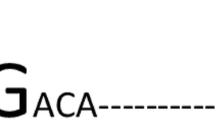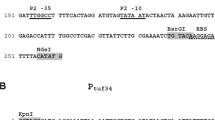Abstract
Lactococcus lactis is industrially important microorganism used in many dairy fermentations. Numerous genes and gene expression signals from this organism have now been identified and characterized. Recently, several naturally occurring, inducible gene-expression systems have also been described inL. lactis. The main features of these systems can be exploited to design genetically engineered expression cassettes for controlled production of various proteins and enzymes. Novel gene-expression systems inLactococcus have great potential for development of industrial cultures with desirable metabolic traits for a variety of bioprocessing applications.
Similar content being viewed by others
References
Van Rooijen, R. J. and de Vos, W. M. (1990) Molecular cloning, transcriptional analysis, and nucleotide sequence oflacR, a gene encoding the repressor of the lactose phosphotransferase system ofLactococcus lactis.J. Biol. Chem. 265, 18,499–18,503.
Van Rooijen, R. J., van Schalkwijk, S., and de Vos, W. M. (1991) Molecular cloning, characterization, and nucleotide sequence of the tagatose 6-phosphate pathway gene cluster of the lactose operon ofLactococcus lactis.J. Biol. Chem. 266, 7176–7181.
Renault, P., Gaillardin, C., and Heslot, H. (1989) Product of theLactococcus lactis required for malolactic fermentation is homologous to a family of positive regulators.J. Bacteriol. 171, 3108–3114.
Stragier, P. and Patte, J. C. (1983) Regulation of diaminopimelate decarboxylase synthesis inEscherichia coli. III. Nucleotide sequence and regulation of thelysR gene.J. Mol. Biol. 168, 333–350.
Wek, R. C. and Hatfield, G. W. (1986) Nucleotide sequence andin vivo expression of theilvY andilvC genes inEscherichia coli K12.J. Biol. Chem. 261, 2441–2450.
Chang, M., Hadero, A., and Crawford, I. P. (1989) Sequence of thePseudomonas aeruginosa trpI activator gene and relatedness oftrpI to other procaryotic regulatory genes.J. Bacteriol. 171, 172–183.
Plamann, L. S. and Stauffer, G. V. (1987) Nucleotide sequence of theSalmonella typhimurium metR gene and themetR-metE control region.J. Bacteriol. 169, 3932–3937.
Van Rooijen, R. J., and de Vos, W. M. (1992) Characterization ofLactococcus lactis lactose operon promoter: contribution of flanking sequences and LacR repressor to promoter activity.J. Bacteriol. 174, 2273–2280.
Eaton, T. J., Shearman, C. A., and Gasson, M. J. (1993) The use of bacterial luciferase genes as reporter genes inLactococcus: regulation of theLactococcus lactis subsp.lactis lactose genes.J. Gen. Microbiol. 139, 1495–1501.
Kuipers, O., Beerthuyzen, M. M., Deruyter, P. G. G. A., Luesink, E. J., and de Vos, W. M. (1995) Autoregulation of nisin biosynthesis inLactococcus lactis by signal transduction.J. Biol. Chem. 270, 27,299–27,304.
Kuipers, O. P., Beerthuyzen, M. M., Siezen, R. J., and de Vos, W. M. (1993) Characterization of the nisin gene clusternisABTCIPR ofLactococcus lactis. Requirement of expression of thenisA andnisI genes for development of immunity.Eur. J. Biochem. 216, 281–291.
de Ruyter, P. G. G. A., Kuipers, O. P., Beerthuyzen, M. M., van Alen-Boerrigter, I., and de Vos, W. M. (1996) Functional analysis of promoters in the nisin gene cluster ofLactococcus lactis.J. Bacteriol. 178, 3434–3439.
de Ruyter, P. G. G. A., Kuipers, O. P., and de Vos, W. M. (1996) Controlled gene expression systems forLactococcus lactis with the food-grade inducer nisin.Appl. Environ. Microbiol. 62, 3362–3367.
de Ruyter, P. G. G. A., Kuipers, O. P., Bijl, L. C., and de Vos, W. M. (1996) Controlled gene expression inLactococcus lactis. Abstract H46 of the 5th Symposium on lactic Acid Bacteria: Genetics, Metabolism, and Applications. Federation of European Microbiological Sciences.
Gasson, M. J. (1996) Lytic systems in lactic acid bacteria and their bacteriophages.Antonie van Leeuwenhoek 70, 147–159.
Payne, J., MacCormick, C. A., Griffin, H. G., and Gasson, M. J. (1996) Exploitation of a chromosomally integrated lactose operon for controlled gene expression inLactococcus lactis.FEMS Microbiol. Lett. 136, 19–24.
Luesink, E. J., Beerthuyzen, M. M. Marugg, J. D., Kuipers, O. P., and de Vos, W. M. (1996) Expression of the divergently transcribed sucrose genes fromLactococcus lactis is controlled by thesacR gene. Abstract H47 of the 5th Symposium on Lactic Acid Bacteria: Genetics, Metabolism, and Applications, Federation of European Microbiological Sciences.
Marugg, J. D., Meijer, W., van Kranenburg, R., Laverman, P., Bruinenberg, P. G., and de Vos, W. M. (1995) Medium-dependent regulation of proteinase gene expression inLactococcus lactis: control of transcription initiation by specific dipeptides.J. Bacteriol. 177, 2982–2989.
Marugg, J. D., van Kranenburg, R., Laverman, P., Rutten, G. A. M., and de Vos, W. M. (1996) Identical transcriptional control of the divergently transcribed prtP and prtM genes that are required for proteinase production inLactococcus lactis SK11.J. Bacteriol. 178, 1525–1531.
Kok, J. (1996) Inducible gene expression and environmentally regulated genes in lactic acid bacteria.Antonie van Leeuwenhoek 70, 129–145.
Sanders, J. W., Leenhouts, K. J., Haandrikman, A. J., Venema, G., and Kok, J. (1995) Stress response inLactococcus lactis: Cloning, expression analysis, and mutation of the lactococcal superoxidase dismutase gene.J. Bacteriol. 177, 5254–5260.
van Asseldonk, de Vos, W. M., and Simons, G. (1993) Cloning, nucleotide sequence, and regulatory analysis of theLactococcus lactis dnaJ gene.J. Bacteriol. 175, 1637–1644.
Madsen, S. M., Vrang, A., and Israelsen, H. (1996) Engineering of a pH regulated promoter fromLactococcus lactis. Abstract H11 of the 5th Symposium on Lactic Acid Bacteria: Genetics, Metabolism, and Applications, Federation of European Microbiological Sciences.
Sanders, J. W., Leenhouts, K., Venema, G., and Kok, J. (1996) Analysis of a chloride-inducible lactococcal promoter. Abstract H22 of the 5th Symposium on Lactic Acid Bacteria: Genetics, Metabolism, and Applications, Federation of European Microbiological Sciences.
Leenhouts, K., Sanders, J. W., Kok, J., Tisminetsky, S., and Baralle, F. (1996) A new inducible expression system forLactococcus lactis, Abstract #E12 of the 5th Symposium on Lactic Acid Bacteria: Genetics, Metabolism, and Applications, Federation of European Microbiological Sciences.
Madsen, M. and Nilsson, D. (1996) Purine regulated promoters inLactococcus lactis. Abstract H7 of the 5th Symposium on Lactic Acid Bacteria: Genetics, Metabolism, and Applications, Federation of European Microbiological Sciences.
Kibenich, A. and Johansen, E. (1996) Food-grade expression of the θML3 lysin gene inLactococcus lactis. Abstract G4 of the 5th Symposium on Lactic Acid Bacteria: Genetics, Metabolism, and Applications, Federation of European Microbiological Sciences.
Schofield, K. M., Wilson, P. W., Le Page, R. F. W., and Wells, J. M. (1996) Optimization of translation initiation inLactococcus lactis. Abstract H44 of the 5th Symposium on Lactic Acid Bacteria: Genetics, Metabolism, and Applications, Federation of European Microbiological Sciences.
Wells, J. M., Wilson, P. W., Norton, P. A., Gasson, M. J., Le Page, R. W. F. (1993)Lactococcus lactis: high-level expression of tetanus toxin fragment C and protection against lethal challenge.Mol. Microbiol. 8, 1155–1162.
Wells, J. M., Wilson, P. W., Norton, P. A., and Le Page, R. W. F. (1993) A model system for the investigation of heterologous protein secretion pathways inLactococcus lactis.Appl. Environ. Microbiol. 59, 3954–3959.
Steidler, L., Wells, J. M., Raeymaekers, A., Vandekerckhove, J., Fiers, W., and Remaut, E. (1995) Secretion of biologically active murine interleukin-2 byLactococcus lactis subsp.lactis.Appl. Environ. Microbiol. 61, 1627–1629.
Davanloo, P., Rosenberg, A. H., Dunn, J. J., and Studier, W. (1984) Cloning and expression of the gene for bacteriophage T7 RNA polymerase.Proc. Natl. Acad. Sci. USA 81, 2035–2039.
Simon, D. and Chopin, A. (1988) Construction of a vector plasmid family and its use for molecular cloning inStreptococcus lactis.Biochimie 70, 559–566.
Halpern, J. L., Habig, W. H., Neale, E. A., and Stibitz, S. (1990) Cloning and expression of functional fragment C of tetanus toxin.Infect. Immunity 58, 1004–1009.
Maeda, S. and Gasson, M. J. (1986) Cloning, expression, and location of theStreptococcus lactis gene for phospho-β-D-galactosidase.J. Gen. Microbiol. 132, 331–340.
Demolder, J., Fiers, W., and Contrears, R. (1992) Efficient synthesis of secreted murine interleukin-2 by Saccharomyces cerevisiae: influence of 3′-untraslated regions and codon usage.Gene 111, 207–213.
MacCormick, C. A., Griffin, H. G., and Gasson, M. J. (1995) Construction of a food-grade host/vector system forLactococcus lactis based on the lactose operon.FEMS Microbiol. Lett. 127, 1,2.
Platteeuw, C., van Alen Boerrigter, Schalkwijk, S., and de Vos, W. M. (1996) Food-grade cloning and expression system forLactococcus lactis.Appl. Environ. Microbiol. 62, 1008–1013.
Platteeuw, C. and de Vos, W. M. (1992) Location, characterization and expression of lytic enzymeencoding gene,lytA, ofLactococcus lactis bacteriophage_US3.Gene 118, 115–120.
Shearman, C., Underwood, H., Jury, K., and Gasson, M. (1989) Cloning and DNA sequence analysis of aLactococcus bacteriophage lysin gene.Mol. Gen. Genet. 218, 214–221.
Sternberg, N., Sauer, B., Hoess, R., and Abremski, K. (1986) Bacteriophage P1cre gene and its regulatory region. Evidence for multiple promoters and for regulation by DNA methylation.J. Mol. Biol. 187, 197–212.
Van der Vossen, J. B. M., van der Lelie, E., and Venema, G. (1987) Isolation and characterization ofStreptococcus cremoris Wg2-specific promoters.Appl. Environ. Microbiol. 53, 2452–2457.
O'Sullivan, D. J., Walker, S. A., West, S. G., and Klaenhammer, T. R. (1996) Development of an expression strategy using a lytic phage to trigger explosive plasmid amplification and gene expression.Bio/Technology 14, 82–87.
Buist, G., Nauta, A., Sanders, J. W., and karsens, H. (1996) Construction of food-grade inducible lysis systems forLactococcus lactis. Abstract G3 of the 5th Symposium on Lactic Acid Bacteria: Genetics, Metabolism and Applications.
Schroeder, C. J., Robert, C., Lenzen, G., McKay, L. L., and Mercenier, A. (1991) Analysis of thelacZ sequences from twoStreptococcus thermophilus strains: comparison withEscherichia coli andLactobacillus bulgaricus β-galactosidase sequences.J. Gen. Microbiol. 137, 369–380.
Hill, C., Pierce, K., and Klaenhammer, T. R. (1989) The conjugative plasmid pTR2030 encodes two bacteriophage defense mechanisms in lactococci, restriction modification (R+/M+) and abortive infection (Hsp+).Appl. Environ. Microbiol. 55, 2416–2419.
Lillehaug, D., Lindqvist, B. H., and Birkeland, N.-K. (1991) Characterization of θLC3, aLactococcus lactis subsp.cremoris temperate bacteriophage with cohesive single-stranded DNA ends.Appl. Environ. Microbiol. 57, 3206–3211.
Walker, S. A., O'Sullivan, D. J., West, S. G., and Klaenhammer, T. R. (1995) Identification of a phageinducible promoter and development of a phage-specific explosive system forLactococcus lactis.J. Dairy. Sci. 78, 108.
Hill, C., Miller, L. A., and Klaenhammer, T. R. (1990) Cloning, expression, and sequence determination of a bacteriophage fragment encoding bacteriophage resistance inLactococcus lactis.J. Bacteriol. 172, 6419–6426.
O'Sullivan, D. J., Hill, C., and Klaenhammer, T. R. (1993) Effect of increasing the copy number of bacteriophage origins of replication, in trans, on incoming phage proliferation.Appl. Environ. Microbiol. 59, 2449–2456.
Dao, M. L. and Ferretti, J. J. (1985)Streptococcus-Escherichia coli shuttle vector pSA3 and its use in the cloning of streptococcal genes.Appl. Environ. Microbiol. 49, 115–119.
Van Sinderen, D., Karsens, H., Kok, J., Terpstra, P., Ruiters, M. H. J., Venema, G., and Nauta, A. (1996) Sequence analysis and molecular characterization of the temperate lactococcal bacteriophage rlt.Mol. Microbiol. 19, 1343–1355.
Nauta, A., van Sinderen, D., Karsens, H., Smit, E., Venema, G., and Kok, J. (1996) Inducible gene expression mediated by a repressor-operator system isolated fromLactococcus lactis bacteriophage rlt.Mol. Microbiol. 19, 1331–1341.
Buist, G., Gökemeijer, J., Venema, G., and Kok, J. (1996b) Functional analysis of the major autolysin ofLactococcus lactis. Abstract G59 of the 5th Symposium on Lactic Acid Bacteria: Genetics, Metabolism, and Applications, Federation of European Microbiological Sciences.
Author information
Authors and Affiliations
Corresponding author
Rights and permissions
About this article
Cite this article
Djordjevic, G.M., Klaenhammer, T.R. Inducible gene expression systems inLactococcus lactis . Mol Biotechnol 9, 127–139 (1998). https://doi.org/10.1007/BF02760814
Issue Date:
DOI: https://doi.org/10.1007/BF02760814




